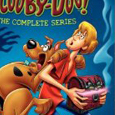Hanna-Barbera (1969), Turner Home Entertainment/Warner Home Video (March 16, 2004), 4 discs, 549 mins plus supplements, 1.33:1 original full frame ratio, Dolby Digital Mono, Rated G, Retail: $64.98
Storyboard:
Four teenagers and a Great Dane solve mysteries involving the supernatural.
The Sweatbox Review:
It’s ironic that the first incarnation of Scooby Doo was called Scooby-Doo, Where Are You?, because the answer is so obvious today. Scooby is everywhere. The Great Dane has never been more popular, being seen in new TV shows, two live action films, several direct-to-video features, and scads of merchandise. It made sense, then, for Warner Bros. Home Video to include the Scoobmeister in its first wave of their Hanna-Barbera Golden Collection.
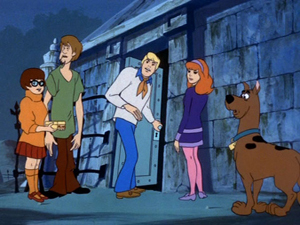
The new four-disc DVD set contains the first two seasons of Scooby-Doo (1969-1971), consisting of 25 episodes total, the majority of them comprising Season One. These shows comprise all of “classic Scooby”, as the next version of the show in 1972 would feature guest stars in the one-hour The New Scooby-Doo Comedy Movies, and later 1970s shows would introduce Scooby-Dum and Scrappy-Doo. Yes, those original two years’ worth of shows were the purest form of Scoobiness to ever be broadcast, and now fans can get them all in one package.
Of course, not everyone will consider this a good thing. Despite the many Scoobyphiles out there, there are probably at least as many people who just do not see the appeal of the show. It had a decent premise— four teenagers and their dog travel around solving mysteries— and a good mix of characters. Scooby himself was a cowardly dog that still managed to come through when it mattered most. His best friend in the group was Shaggy, a hippie who— like Scooby— was more interested in eating and mellowing out than solving mysteries. The leader of the group was Freddy Jones, an ascot-wearing fellow who looked like a dandy but was actually smart and serious. Daphne was a cute curvy redhead who was a trifle accident-prone and had a talent for getting kidnapped. And Velma was the smart, frumpy one, dressed in a turtleneck and knee-high socks. The biggest mystery, looking back, is how this socio-economically diverse group ever managed to become friends in the first place. Now that could make a decent movie!

The problem with the show is that the mysteries were never too tough to solve. In fact, in most episodes, there was only one suspect introduced! Occasionally, the writers (mostly Joe Ruby and Ken Spears) would throw out a red herring to put the viewer off the trail, but that was rare. The animation was also typical of Hanna-Barbera TV shows, done on the cheap with limited animation and questionable draftsmanship. The plots were also somewhat repetitive, always featuring the gang wandering about for little apparent reason in their van (the “Mystery Machine”) until they stumbled upon some mysterious being that more often than not was termed a “ghost”, even if it had no ghostly qualities. Other monsters they came up against included pirates, werewolves, mummies, witches, and vampires. Oftentimes, the ghost motif would be superimposed over something else, resulting in a Clown Ghost, an Old Miner’s Ghost, The Ghost of Mr. Hyde, an Alien Ghost, and so forth.
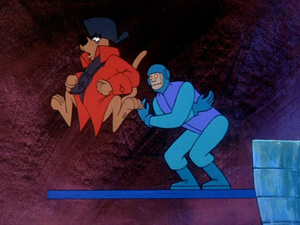
Each time, the monster in question would be trying to scare people away for some diabolical reason that always had to do with money or treasure. During the story, the bad guy would first chase gang, and then they would chase the bad guy back again. Freddy would tell Shaggy, Velma, and Scoob to look somewhere else, while he made time with pretty Daphne (even as a kid, I picked up on that angle). Despite the fact that the gang practically always met the actual perpetrator in the first few minutes of the episode, they were (almost) always astonished to find out that it was in fact that person who had dressed up to frighten them away. Once this formula was established, the show rarely wandered from it. For kids, though, such familiarity can be comforting, and this was after all a Saturday morning cartoon for the small fry.
So why do so many adults still love Scooby-Doo? Are we not all grown up now, with more demanding tastes? Can our love for Scooby be entirely reduced to blind nostalgia?

Well, nostalgia no doubt plays a large role; but Scooby-Doo has its good points too. The chemistry between the characters makes the show, just as it does in any conventional sitcom. Basically, once Lucille Ball finished filming I Love Lucy, there were not too many plots left untouched for a G-rated comedy, so any TV show since then has had to rely on character interaction to interest the audience. The Scooby gang, with their diverse personalities and interests, are hardly well rounded as individuals, but they do make an appealing group of characters. Okay, Freddy was usually just looking to sneak away with Daphne while sending the others to do the tough stuff, but overall the group had a very likeable dynamic. There is something appealing about seeing such different people hanging out together and enjoying each other’s company. These folks were fast friends, and you never saw them argue with each other in the old shows. There was enough conflict with the bad guys that the main characters did not have to come into anything more than light conflict in order for the show to keep one’s interest… well, to a point. As there was so little conflict presented, the characters never evolved or developed new twists to their relationships, either. Still, that was standard for a kiddie show back then.
The antics of Scooby and Shaggy, naturally, were at the heart of the show. There is no love quite like that of the love between a young man and his dog. Despite the difference in species, these two were platonic soul mates. They both understood the pleasantness of chocolate sauce inside a submarine sandwich or the joy of a pickle on a strawberry sundae. They were also brothers-in-cowardice, taking turns being the bigger chicken. Without their playfulness, the show would have had almost no personality at all. Much credit can go to the vocal performance of the great Don Messick (Scooby) and Casey Kasem (Shaggy).
It’s strange to consider, then, that the show originally did not have Scooby in it at all when it was first developed by Ruby and Spears. The dog was only added out of network concern for the show being too spooky and dramatic for kids. The dog’s name later came from a Frank Sinatra song; the naming of Scooby has been attributed to Iwao Takamoto.
Speaking of Mr.Takamoto, no discussion of Scooby could be complete without mentioning his contribution. Takamoto was the main designer on the show, and it was largely his conception of the kids and their environment that contributed to the show’s success. Those designs still hold up well today and make the show very watchable despite the paper-thin plots; but certainly back in 1969 the appearance of the show would have been even more striking. Though it was a comedy, it had a delighfully creepy and even gothic look that made it stand out from any other kiddie programs.
As an adult, I think that is what really brings me back to view the show, despite its limitations. The creepy atmosphere created by the backgrounds made the show for me, evoking a nice sense of “old dark house” or “dark old bog” or “dodgy little shop”, as needed. It made for a good counterbalance for the goofiness of Scooby and Shaggy, while allowing us to take the matter of hauntings more seriously. Most importantly, the backgrounds provided a feigned sense of mystery and danger despite us knowing that there was only one real suspect and that the gang would solve the case unharmed in the end.

That sense of mystery started to erode a bit in the second season, when someone had the idea to inject pop rock songs into the stories. Even the theme song was re-done, with a bouncier and lighter feel to it. Additionally, groovy bubblegum tunes would be inserted into a chase scene around the middle of the story. The lyrics would have nothing to do with the onscreen action, and yet as a child I never questioned it. Now, I find the juxtaposition jarring. One cannot deny, however, that the second season of Scooby Doo was a product of its time, having been no doubt influenced by the musical numbers in Filmation’s terrifically successful The Archie Show, and that the use of music in Scooby further influenced countless other mystery cartoons over the next few years.
While there have been better cartoons produced for television, there are reasons why Scooby-Doo’s shortcomings are overlooked. Sometimes, you just cannot beat chemistry. Scooby and the gang have it, and for that reason I can still watch the show and get a chuckle out of it.
The DVD set, as mentioned earlier, collects all 25 episodes from the first two seasons. The packaging makes no distinction when Season 2 begins, but the shows are presented in broadcast order and it is easy to tell when the transition is when you watch the shows. The Mr. Hyde episode (#18) is the first to carry the 1970 copyright, as well as the new opening and songs. There seems to be little point in making comments about the individual episodes this time around, since they are frankly quite similar to one another. The locales include a spooky circus, a spooky ship, a spooky theater, a spooky castle… well, you get the idea.
By the way, the villain does not really always say “And I would’ve gotten away with it too, if it weren’t for those meddling kids”. In fact, no such line is heard in the first several episodes, and afterwards it appears infrequently and with different variations. Also, Freddy does sometimes let Velma tag along with him and Daphne.
Is This Thing Loaded?
Well, the extras on this box set are like a box full of cotton candy— lots of fluff that looks like it takes up a lot of room but is really only a spoonful of sugar and some artificial coloring. Most of it is not even worthwhile checking out once.
Disc 2 has the first two features. Scooby-Doo’s Ultimate Fans (11:52) introduces us to three Scooby collectors and their huge collections. The men themselves are a little scary (I mean, I like Scooby too, but, yikes!), but it is fun to see some of the vintage memorabilia that they have each accumulated. I believe this is actually the strongest bonus feature, since it does let us see some cool toys, comics, and so forth. Get The Picture: How To Draw Scooby-Doo And The Gang (2:20) is another of those brief speed-drawing things that Warner Bros. keeps including on their animation DVD’s. This one does not even turn out too well, since the characters get drawn out of proportion with one another; Velma looks huge!
Funky Fashion (4:51) appears on Disc 3. Clips from the show support a narrator who describes how the gang dresses. Okaaaaay… moving right along we have something not much better, America Loves Scooby-Doo (2:32), a country music video with clips from the newer direct-to-video movies.
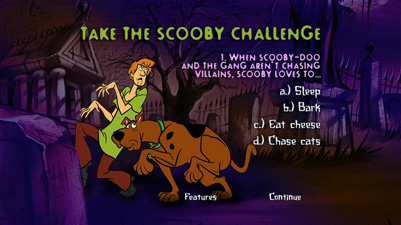
The final disc includes the lamest features yet. Scooby-Doo Street Smarts (2:46) has comments from people who like Scooby-Doo— not exciting. Lastly and probably least, there is Take The Scooby-Doo Challenge, a trivia contest with a grand total of four questions and no reward. There is also a link to Family Favorites, featuring trailers for the new TV show’s DVD single disc Scooby-Doo: Safari So Goodi!, the upcoming direct-to-video movie Scooby-Doo And The Loch Ness Monster, and the Flintstones Complete Season One set; this last trailer is most notable for also showing the cover art for the upcoming Jetsons set and the still-not-officially-announced Tom And Jerry set.
Sometimes, I wish that a DVD would have no extras at all, rather than having the studio spend money on really useless ones.
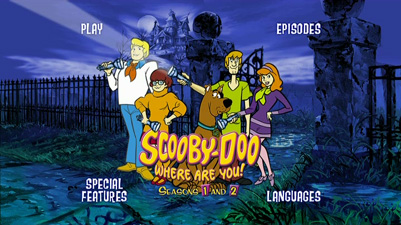
One thing I will not complain about is the design of the menus, which is nice and functional. The main menu has some opening animation that leads to a simple interface, where the characters from the show highlight selections with their flashlights. The selections allow you to play all the episodes, or to select from the individual ones in a separate menu. On that screen, the monster of the week appears in a doorway behind one of the characters when that particular episode is highlighted. Neat.
Case Study:
The packaging for this example from the Hanna-Barbera Golden Collection is pretty spiffy, with a digipack inside of a clear plastic slipcase. The effect is that of a painted cel drawing superimposed on a drawn background— very slick and classy to see. I only wish that the slipcase had been made a little looser, as it is tricky to take off and put on again.
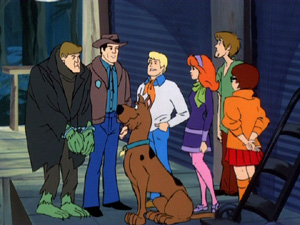
Ink And Paint:
I found the video quality to be more uniform than in the Flintstones set that was released the same day. The transfers were very well done, with no hint of compression artifacts of any type. Colors are solid and appropriately funky-looking, with bright characters against gloomy backgrounds, providing the proper ambience for Scooby’s adventures. That’s the good news. The kind-of bad news is, these shows look just like you remember them, with many instances of dust and smudges that were predominantly, I think, original to the filmed cels. You can tell this when the camera pans, and the dust specks stick to the background rather than moving with the shot. Wherever the old Hanna-Barbera shows were filmed, there sure seemed to be a lot of dust all over everything. Nevertheless, the DVDs provide a perfect representation of the shows as they were made and originally shown. Would fans have it any other way?
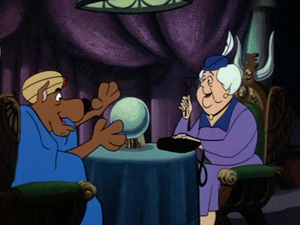
Scratch Tracks:
On the audio side, we also get the true sound of the show. It’s all mono, baby, with limited dynamic range. If you really wanted a booming 5.1 remix, you will have to settle for dabbling with your receiver’s settings. For myself, I found the audio quality to be just fine. I doubt the show could sound any better than what is on these discs. Only English audio is available, but subtitles come in English, French, and Spanish.

Final Cut:
The video and audio quality are as good as can be, which to me is more important than the lack of substantial extras. Sure, I would have appreciated some Ruby-Spears commentary, production art, and a featurette on the various permutations of the show, but most of all I want the cartoons in good condition; and that is what this set is intended to provide.
If one must own some Scooby for the ol’ DVD collection, this is the set to get. It’s pure undiluted Scoobiness, and 100% Scrappy-free! I am glad that I resisted the temptation for all those single-disc compilations that have come out the past few years, since these are really the cartoons I want the most. I was not sure initially if I would be happy with these cartoons again, after not having seen them for several years, but I found them quite enjoyable, even watching four or five in a row. It may not be challenging television, but it is what it is meant to be: clean fun.
 | ||
 |









